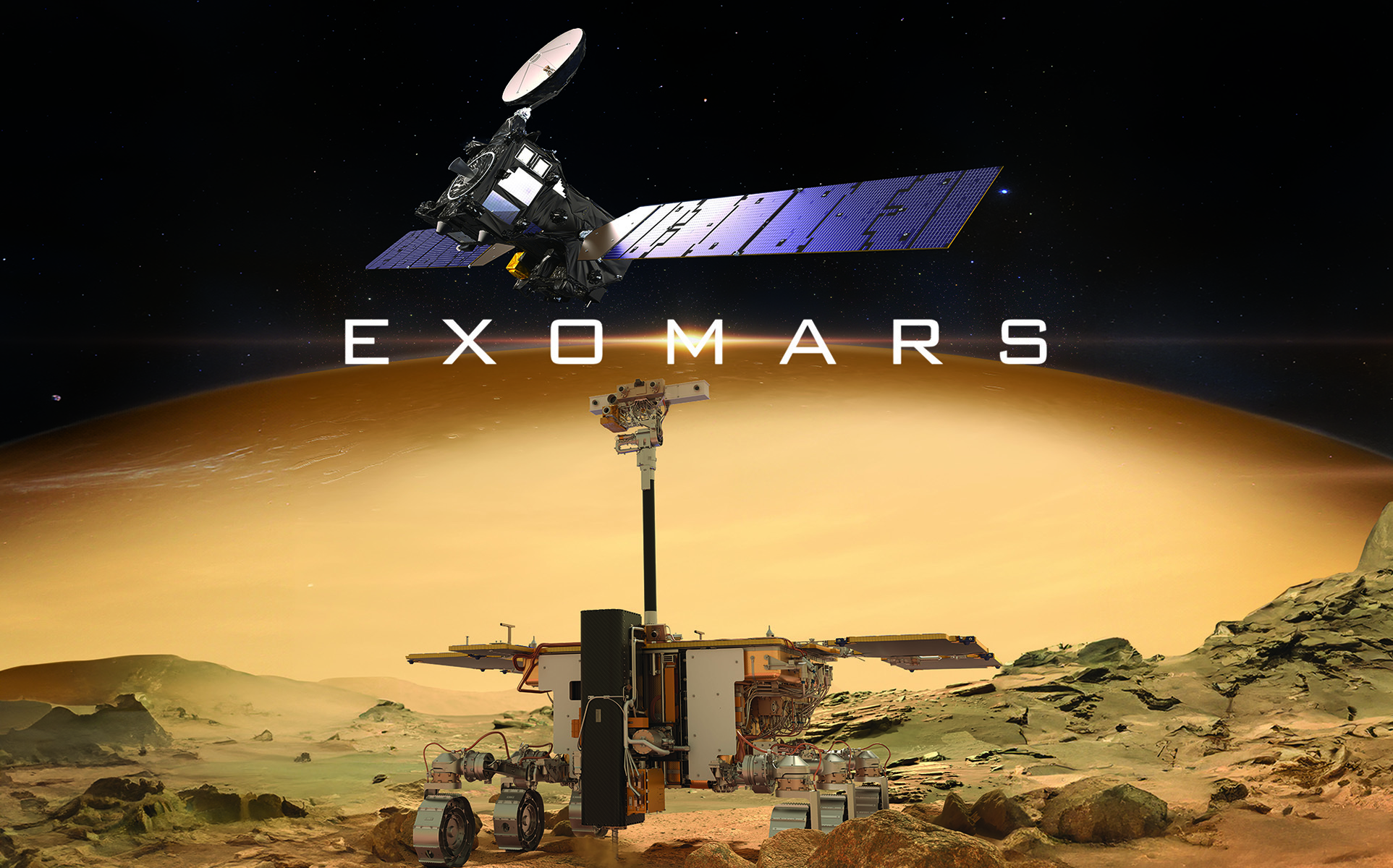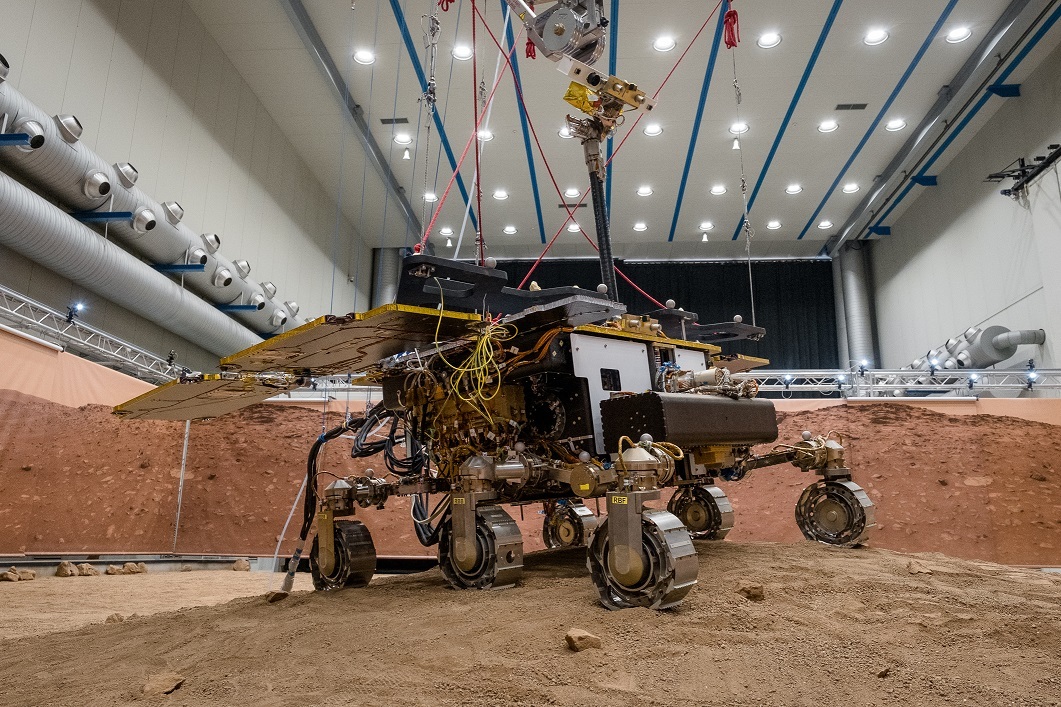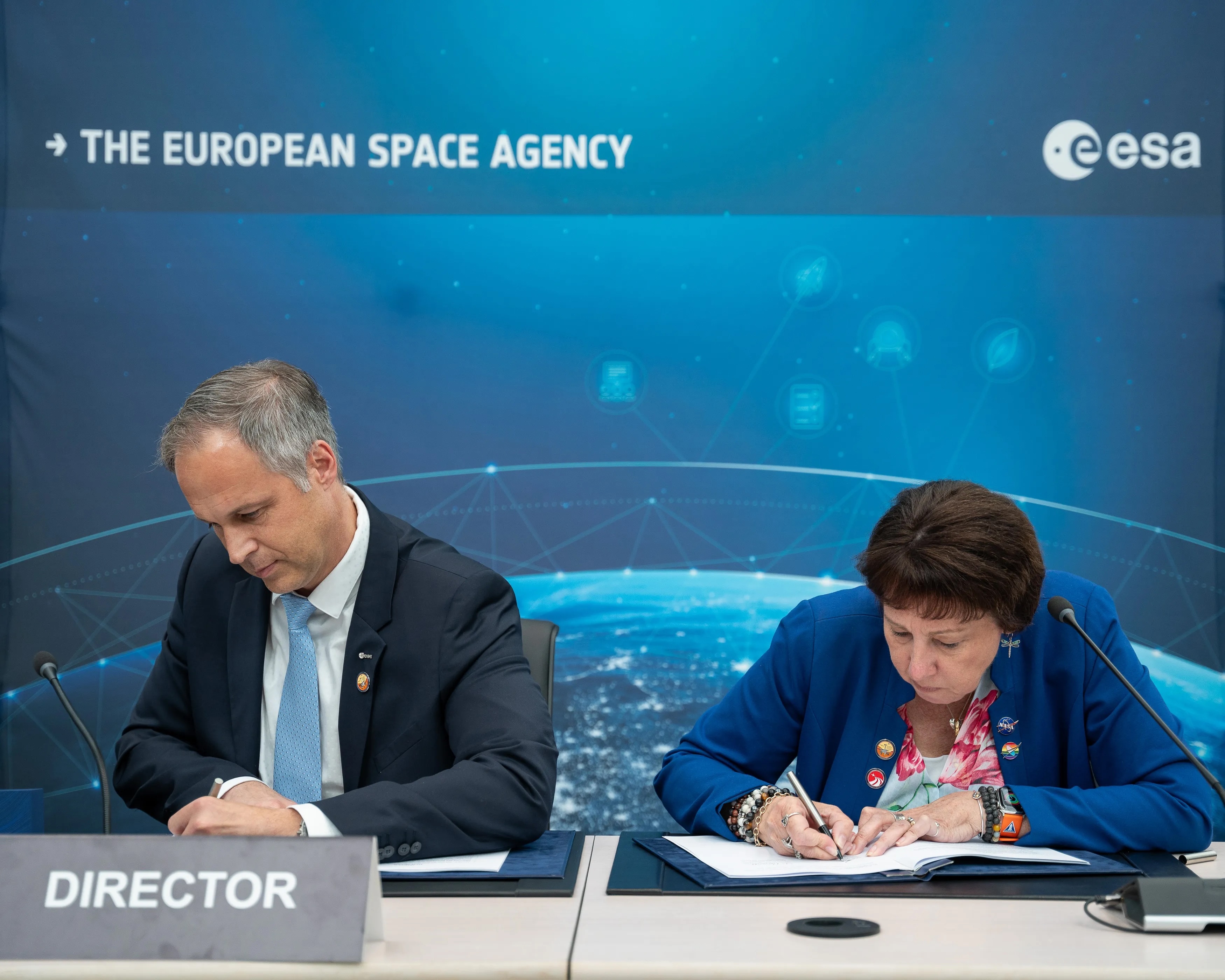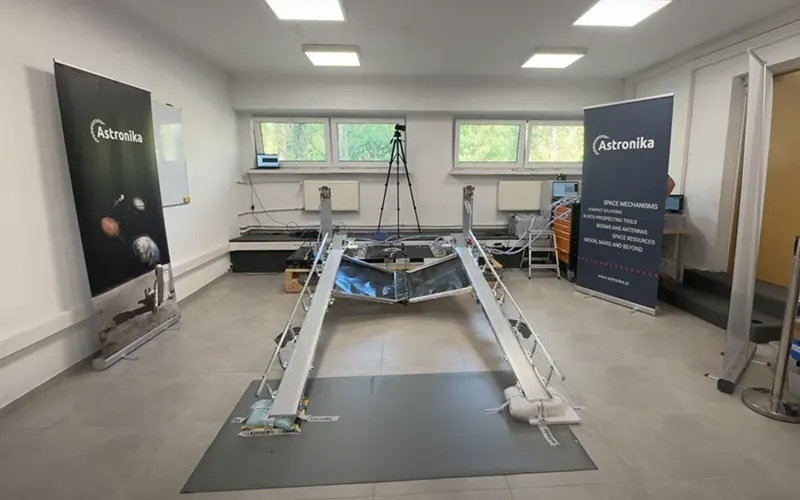9.04.2024
THE SEARCH FOR LIFE ON MARS GOES ON WITH EXOMARS 2028
Thales Alenia Space has signed a contract with the European Space Agency to continue work to take a European rover to search for traces of life on Mars
- The European mission to Mars is restarting thanks to the determination of the European Space Agency supported by the Italian Space Agency, the UK Space Agency and a renewed partnership with NASA, with the mission’s original science objectives preserved.
- ExoMars 2028 is an unprecedented scientific and technological challenge, from the use of innovative materials for thermal protection during entry into Mars’s atmosphere to the development of software for navigation, control and landing on the planet’s surface.
- The results of these technological challenges will make a fundamental contribution to the ongoing robotic and human exploration of the Red Planet and Solar System.
Turin, April 9, 2024 – Thales Alenia Space, a joint venture between Thales (67%) and Leonardo (33%), has signed a framework contract divided into different tranches with the European Space Agency (ESA), worth a total of €522m, to continue essential activities for the completion of the ExoMars 2028 mission. The contract includes the development of the Mars Entry, Descent and Landing Module (EDLM) and maintenance activities on vehicles already built for the 2022 mission.
The upcoming ExoMars mission, set for launch from the Kennedy Space Center between October and December 2028, will explore the Martian surface in search of signs of past life, a quest that has long fascinated humanity. Led by ESA with a major involvement by NASA, ExoMars 2028 will deliver a European rover capable of autonomous driving on the planet’s surface. Scheduled to reach Mars in 2030 after a long voyage, the rover, fitted with a drill developed by Leonardo, will collect soil samples by drilling into the Martian soil up to 2 meters deep and will analyze their chemical, physical and biological properties using its advanced Analytical Laboratory Drawer (ALD) developed by Thales Alenia Space. One of the mission objectives is to search for subsurface bacteria, living or fossilized, which would be evidence of extant or previous life on the Red Planet.

Thales Alenia Space_Master Images Programmes
In the meantime, the ExoMars Trace Gas Orbiter (TGO), built with Thales Alenia Space as prime contractor, is still orbiting Mars. Tasked with detecting trace gases, especially methane, in the Martian atmosphere, TGO plays a key role in understanding potential indicators of life on Mars. Additionally, it continues to transmit most of the data from Mars, including from NASA’s Curiosity and Perseverance rovers, contributing to ongoing research efforts. TGO still has a significant amount of fuel, and its operational life will be extended to support the ExoMars 2028 mission.
Thales Alenia Space’s role
As industrial prime contractor for the ExoMars 2028 mission, Thales Alenia Space is responsible for designing the Entry, Descent and Landing Module (EDLM), developing its radar altimeter, integrating the Analytical Laboratory Drawer (ALD) on the rover and developing the onboard computer. Thales Alenia Space is also responsible for assembly, integration and test activities (AIT), as well as overseeing the launch campaign.
Under this contract, Thales Alenia Space will lead the definition of the Entry, Descent and Landing Module and maintenance activities for the transfer module (carrier) and the rover, including upgrades and replacement of time-sensitive elements. A full audit and tests will be carried out on the rover to ensure its readiness for the new mission. In addition, replacement of some payload elements is planned, such as integration of the new Enfys infrared spectrometer. The batteries and tanks will be replaced on the carrier module as well as potential adjustments to align with the updated trajectories to Mars. New developments on the descent module and landing pad are also required, because the European avionics part of the descent module will be reused.

Thales Alenia Space
"From the Sun to Saturn, and from Mercury to Venus, Jupiter and Mars, our solutions have been on every space odyssey seeking to unveil the universe’s most closely guarded secrets" said Thales Alenia Space CEO, Hervé Derrey. "In the near future, the Moon, with ARTEMIS II and III missions, will be in the spotlight and our company will be in the front seat of manned lunar exploration, working in particular on Orion spacecraft’s European service module, Gateway cislunar space station and lunar multi-purpose habitats. Today’s ExoMars 2028 contract strengthens Thales Alenia Space’s position as a major leader in the field of space exploration."
“We’re truly honored that ESA has renewed its trust in our company by awarding us the contract for the renewal of this challenging mission to search for traces of life on Mars,” said Massimo Comparini, Deputy CEO and Senior Executive Vice President, Observation, Exploration and Navigation at Thales Alenia Space. “Thales Alenia Space’s advanced technology, know-how and experience puts us at the forward edge of space exploration. Today, we’re celebrating the follow-up of an extraordinary international program, the result of constructive synergy and cooperation between ESA, the other agencies involved and the space industry. We’re ready for the crucial months ahead and confident in our ability to keep pushing the boundaries of Universe exploration, thanks to the constant work of our specialist engineers and technicians, committed every day to meeting these challenges.”
Industrial consortium: who’s doing what?
Thales Alenia Space in Italy is leading a consortium comprising Airbus Defence & Space in the UK for the rover vehicle and for the mechanical, thermal and propulsion systems of the landing module; ArianeGroup (France) for the front shield and thermal protection part of the aeroshell; OHB (Germany) for the carrier module; and ALTEC (Italy) for the Rover Operations Control Center (ROCC). Our teams in France are responsible for developing part of the aeroshell (the rear shield) and the parachute, while Thales Alenia Space in Switzerland will supply the cameras and the electronic control unit for the landing module’s braking engines. Furthermore, Thales Alenia Space in Spain supplied the Actuator Drive Electronics (ADE) of the rover.
ABOUT THALES ALENIA SPACE
Drawing on over 40 years of experience and a unique combination of skills, expertise and cultures, Thales Alenia Space delivers cost-effective solutions for telecommunications, navigation, Earth observation, environmental management, exploration, science and orbital infrastructures. Governments and private industry alike count on Thales Alenia Space to design satellite-based systems that provide anytime, anywhere connections and positioning, monitor our planet, enhance management of its resources, and explore our Solar System and beyond. Thales Alenia Space sees space as a new horizon, helping to build a better, more sustainable life on Earth. A joint venture between Thales (67%) and Leonardo (33%), Thales Alenia Space also teams up with Telespazio to form the parent companies’ Space Alliance, which offers a complete range of services. Thales Alenia Space posted consolidated revenues of approximately 2.2 billion euros in 2023 and has around 8,600 employees in 17 sites in 10 countries across Europe and a plant in the USA.
Quelle: THALES ALENIA SPACE
----
Update: 18.05.2024
.
NASA, European Space Agency Unite to Land Europe’s Rover on Mars

NASA and ESA (European Space Agency) announced Thursday they signed an agreement to expand NASA’s work on the ExoMars Rosalind Franklin rover, an ESA-led mission launching in 2028 that will search for signs of ancient life on the Red Planet.
With this memorandum of understanding, the NASA Launch Services Program will procure a U.S. commercial launch provider for the Rosalind Franklin rover. The agency will also provide heater units and elements of the propulsion system needed to land on Mars. A new instrument on the rover will be the first drill to a depth of up to 6.5 feet (2 meters) deep below the surface to collect ice samples that have been protected from surface radiation and extreme temperatures.
“The Rosalind Franklin rover’s unique drilling capabilities and onboard samples laboratory have outstanding scientific value for humanity’s search for evidence of past life on Mars,” said Nicola Fox, associate administrator, Science Mission Directorate at NASA Headquarters in Washington. “NASA supports the Rosalind Franklin mission to continue the strong partnership between the United States and Europe to explore the unknown in our solar system and beyond.”
Through an existing, separate partnership with the German Aerospace Center (DLR) and the French space agency CNES (Centre National d’Etudes Spatiales), NASA is contributing key components to the Rosalind Franklin rover’s primary science instrument, the Mars Organic Molecule Analyzer, that will search for the building blocks of life in the soil samples.
NASA has a longstanding partnership with the Department of Energy to use radioisotope power sources on the agency’s space missions and will be partnering again with the Energy Department for the use of lightweight radioisotope heater units for the rover.
The Rosalind Franklin rover mission complements the Mars Sample Return multi-mission campaign led by both agencies.
Quelle: NASA
----
Update: 23.07.2025
.

ExoMars parachutes ready for martian deployment
The most complex parachute system to ever deploy on Mars has successfully slowed down an ExoMars mock-up landing platform for a safe touchdown on Earth.
A stratospheric helium balloon lifted a dummy descent module and released it above the Arctic Circle at an altitude of nearly 30 km, triggering the deployment of two large parachutes from their doughnut bags.
“We are happy to confirm that we have a parachute design that can work on Mars – an ambitious system with the largest parachute ever to be flown outside Earth,” says Luca Ferracina, ESA’s ExoMars Entry Descent and Landing Module system engineer.

Access the video
This high-altitude drop test campaign took place at the Swedish Space Corporation’s Esrange Space Center in Kiruna, northern Sweden, on 7 July.
How to test a Mars landing on Earth
To match the combination of density and speed that the capsule will experience when diving into the thin martian atmosphere – about 1% of the density of Earth's atmosphere at sea level – the balloon had to fly very high.
The ExoMars parachutes dropped from an altitude of 29 km, or about three times the altitude where commercial aircraft cruise.

The dummy capsule then went into free-fall for about 20 seconds, reaching almost the speed of sound, before deploying the parachutes in turn.
“The combination of velocity and low atmospheric density in this test is exactly the same as what the parachutes will experience on Mars. Testing on Earth is a way to gain confidence and confirm that all the elements perform as expected,” explains Luca.
High-altitude drop tests require complex logistics and strict weather conditions for flight safety. Esrange's unique facilities and long heritage of stratospheric balloon missions since the early 1970s make it a suitable location for the campaign.
Two are better than one
Landing on Mars is a high-risk endeavour. In just six minutes, the descent module has to decelerate from 21 000 km/h at the top of the planet’s atmosphere to a soft landing to keep its precious cargo, the Rosalind Franklin rover, fit for surface exploration.

Slowing down requires a thermal shield, two main parachutes – each with its own pilot chute for extraction – and a retro-rocket propulsion system triggered 20 seconds before touching the martian surface.
Most of the supersonic velocity will decrease due to the aerodynamic drag of the capsule. The most efficient way to remove the remaining speed for a safe landing is with a combination of parachutes and retro-rockets.
“Using two parachutes allows us to design a strong, medium-sized parachute to decelerate the probe through supersonic speeds and then a much larger, lightweight parachute for the final descent,” explains John Underwood, principal engineer at Vorticity, the UK company entrusted with parachute design and test analysis.
Working in tandem
The first stage main parachute is 15 m-wide, similar to the type of parachutes designed for landing NASA’s Viking Mars spacecraft in 1972. For ExoMars, teams are using a variant designed for the successful ESA Cassini-Huygens mission to Titan, Saturn’s largest moon. This three-stage parachute system still holds the record for the most distant landing from Earth ever attempted.

The second stage main parachute is 35 m-wide and it is formed from a series of rings with gaps in between them. This will be the largest parachute to ever fly on Mars or anywhere in the Solar System besides Earth. Made from over 800 square metres of fabric and more than four kilometres of cord for the suspension lines, it takes around three days to fold it inside its bag.
The meticulous folding of each parachute inside its bag is essential to guarantee a correct deployment.
Storage and design challenges
The parachute system tested in Sweden was already qualified to fly to Mars in 2021, but was stored when the mission was put to a halt due to Russia’s invasion of Ukraine.

“We are running this campaign to confirm our readiness for Mars, and to verify that the parachutes are still performing as expected after the long storage,” explains Luca.
The parachutes are each manufactured from very light fabric with a density of about 40 grams per square metre – about half that of a sheet of paper.
Parachute expertise elevating Europe
While telemetry was delivered in real time during the drop, the Vorticity team will now analyse the data together with high-speed video footage to evaluate the deceleration profile and inflation models.

“Testing on Earth has the advantage that we can obtain much more data and recover the parachutes for inspection after the test,” says John.
The majority of the parachute system has been designed and built in Europe, including components from the Netherlands (the deployment mortars), Italy (parachutes) and Czechia (the parachute container). Thales Alenia Space in France supervised the test campaign as responsible for the parachute assembly system.
Quelle: ESA
----
Update: 7.11.2025
.
ExoMars Rover Ramp Built by Poland’s Astronika Passes Key Milestone

Credit: ESA / Astronika
A pair of ramps that will allow the European Space Agency’s (ESA) Rosalind Franklin rover to roll from its landing platform onto the surface of Mars has passed a key testing milestone.
In early 2024, ESA awarded Thales Alenia Space a €522 million contract to replace key components of its ExoMars mission that were lost after the agency severed ties with its former project partner, Roscosmos. The mission will deliver the Rosalind Franklin rover to the Martian surface to hunt for signs of past life. In March 2025, ESA and Thales Alenia Space awarded Airbus a £150 million contract to develop and build the landing platform for ESA’s ExoMars mission. A key element of the landing platform is the egress system that will bridge the gap between the platform and the surface below.
The system features two sets of deployable three-metre-long ramps that will provide the rover with two paths down to the surface of Mars. Each ramp is made of lightweight aluminium with a honeycomb pattern designed to improve traction as the rover’s six wheels traverse it. The ramps are equipped with guiderails, hold-down and release mechanisms, passive spring-driven hinges for deployment, and sensors that confirm their position. When activated, the system deploys the ramps at an angle of approximately 20 degrees below the lander’s platform.
While Airbus was only awarded the contract to develop the landing platform in March, Polish space-mechanics specialist Astronika appears to have begun work on the egress system at least a year earlier. In a June 2024 update, the company stated that “Polish engineers, among others, will save the European Space Agency’s historic mission to Mars,” and outlined its role in the project, which includes developing the ramps. Its involvement was formally confirmed in April 2025, a month after Airbus was named as the landing platform’s prime contractor.
On 31 October, ESA revealed that a confidence test conducted at Astronika’s facility in Warsaw successfully demonstrated the deployment of both ramps, a process that will take approximately five minutes on the surface of the Red Planet. A confidence test is a full-scale verification exercise that confirms the hardware functions as intended under realistic operational conditions.
The egress system’s design will continue through further testing phases, including environmental and qualification campaigns, ahead of final integration with the landing platform.
Quelle: European Spaceflight
